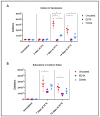The Platelet Fraction Is a Novel Reservoir to Detect Lyme Borrelia in Blood
- PMID: 33137967
- PMCID: PMC7694117
- DOI: 10.3390/biology9110366
The Platelet Fraction Is a Novel Reservoir to Detect Lyme Borrelia in Blood
Abstract
Serological diagnosis of Lyme disease suffers from considerable limitations. Yet, the technique cannot currently be replaced by direct detection methods, such as bacterial culture or molecular analysis, due to their inadequate sensitivity. The low bacterial burden in vasculature and lack of consensus around blood-based isolation of the causative pathogen, Borrelia burgdorferi, are central to this challenge. We therefore addressed methodological optimization of Borrelia recovery from blood, first by analyzing existing protocols, and then by using experimentally infected human blood to identify the processing conditions and fractions that increase Borrelia yield. In this proof-of-concept study, we now report two opportunities to improve recovery and detection of Borrelia from clinical samples. To enhance pathogen viability and cultivability during whole blood collection, citrate anticoagulant is superior to more commonly used EDTA. Despite the widespread reliance on serum and plasma as analytes, we found that the platelet fraction of blood concentrates Borrelia, providing an enriched resource for direct pathogen detection by microscopy, laboratory culture, Western blot, and PCR. The potential for platelets to serve as a reservoir for Borrelia and its diagnostic targets may transform direct clinical detection of this pathogen.
Keywords: Borrelia; EDTA; Lyme disease; OspA; blood processing; citrate; culture; diagnosis; molecular detection; platelets.
Conflict of interest statement
The authors declare no conflict of interest. The funders had no role in the design of the study; in the collection, analyses, or interpretation of data; in the writing of the manuscript, or in the decision to publish the results.
Figures






Similar articles
-
Polymerase chain reaction in diagnosis of Borrelia burgdorferi infections and studies on taxonomic classification.APMIS Suppl. 2002;(105):1-40. APMIS Suppl. 2002. PMID: 11985118
-
Nested-PCR real time as alternative molecular tool for detection of Borrelia burgdorferi compared to the classical serological diagnosis of the blood.Med Dosw Mikrobiol. 2016;68(1):47-56. Med Dosw Mikrobiol. 2016. PMID: 28146622
-
Development of a sensitive PCR-dot blot assay to supplement serological tests for diagnosing Lyme disease.Eur J Clin Microbiol Infect Dis. 2018 Apr;37(4):701-709. doi: 10.1007/s10096-017-3162-x. Epub 2017 Dec 27. Eur J Clin Microbiol Infect Dis. 2018. PMID: 29282568 Free PMC article.
-
Direct detection methods for Lyme Borrelia, including the use of quantitative assays.Vector Borne Zoonotic Dis. 2002 Winter;2(4):223-31. doi: 10.1089/153036602321653806. Vector Borne Zoonotic Dis. 2002. PMID: 12804163 Review.
-
Progress in the molecular diagnosis of Lyme disease.Expert Rev Mol Diagn. 2017 Jan;17(1):19-30. doi: 10.1080/14737159.2016.1246959. Epub 2016 Nov 28. Expert Rev Mol Diagn. 2017. PMID: 27892737 Review.
Cited by
-
Platelet-derived major histocompatibility complex class I coating on Treponema pallidum attenuates natural killer cell lethality.Virulence. 2024 Dec;15(1):2350892. doi: 10.1080/21505594.2024.2350892. Epub 2024 May 14. Virulence. 2024. PMID: 38745370 Free PMC article.
-
One health approach to study human health risks associated with Dermanyssus gallinae mites.Heliyon. 2024 May 1;10(9):e30539. doi: 10.1016/j.heliyon.2024.e30539. eCollection 2024 May 15. Heliyon. 2024. PMID: 38742058 Free PMC article.
References
-
- Godar D.A., Laniosz V., Wetter D.A. Lyme Disease Update for the General Dermatologist. Am. J. Clin. Dermatol. 2015;16:5–18. - PubMed
Grants and funding
LinkOut - more resources
Full Text Sources
Molecular Biology Databases

